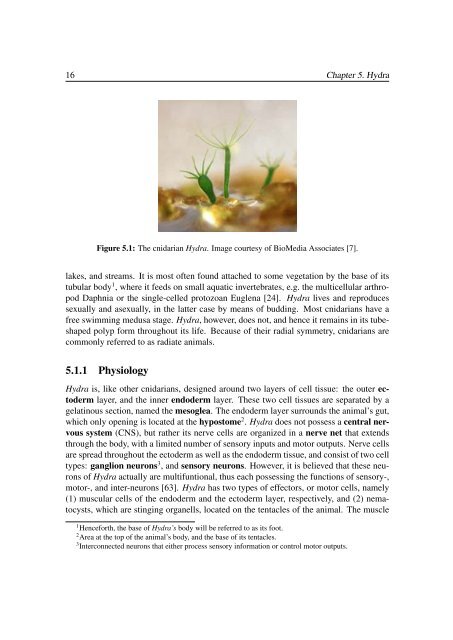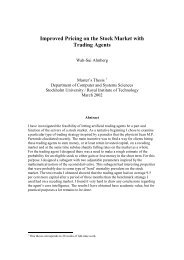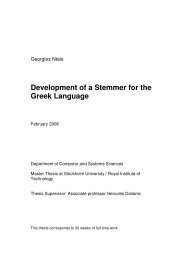Modeling Hydra Behavior Using Methods Founded in Behavior-Based Robotics
Modeling Hydra Behavior Using Methods Founded in ... - SAIS
Modeling Hydra Behavior Using Methods Founded in ... - SAIS
You also want an ePaper? Increase the reach of your titles
YUMPU automatically turns print PDFs into web optimized ePapers that Google loves.
16 Chapter 5. <strong>Hydra</strong>Figure 5.1: The cnidarian <strong>Hydra</strong>. Image courtesy of BioMedia Associates [7].lakes, and streams. It is most often found attached to some vegetation by the base of itstubular body 1 , where it feeds on small aquatic <strong>in</strong>vertebrates, e.g. the multicellular arthropodDaphnia or the s<strong>in</strong>gle-celled protozoan Euglena [24]. <strong>Hydra</strong> lives and reproducessexually and asexually, <strong>in</strong> the latter case by means of budd<strong>in</strong>g. Most cnidarians have afree swimm<strong>in</strong>g medusa stage. <strong>Hydra</strong>, however, does not, and hence it rema<strong>in</strong>s <strong>in</strong> its tubeshapedpolyp form throughout its life. Because of their radial symmetry, cnidarians arecommonly referred to as radiate animals.5.1.1 Physiology<strong>Hydra</strong> is, like other cnidarians, designed around two layers of cell tissue: the outer ectodermlayer, and the <strong>in</strong>ner endoderm layer. These two cell tissues are separated by agelat<strong>in</strong>ous section, named the mesoglea. The endoderm layer surrounds the animal’s gut,which only open<strong>in</strong>g is located at the hypostome 2 . <strong>Hydra</strong> does not possess a central nervoussystem (CNS), but rather its nerve cells are organized <strong>in</strong> a nerve net that extendsthrough the body, with a limited number of sensory <strong>in</strong>puts and motor outputs. Nerve cellsare spread throughout the ectoderm as well as the endoderm tissue, and consist of two celltypes: ganglion neurons 3 , and sensory neurons. However, it is believed that these neuronsof <strong>Hydra</strong> actually are multifuntional, thus each possess<strong>in</strong>g the functions of sensory-,motor-, and <strong>in</strong>ter-neurons [63]. <strong>Hydra</strong> has two types of effectors, or motor cells, namely(1) muscular cells of the endoderm and the ectoderm layer, respectively, and (2) nematocysts,which are st<strong>in</strong>g<strong>in</strong>g organells, located on the tentacles of the animal. The muscle1 Henceforth, the base of <strong>Hydra</strong>’s body will be referred to as its foot.2 Area at the top of the animal’s body, and the base of its tentacles.3 Interconnected neurons that either process sensory <strong>in</strong>formation or control motor outputs.





